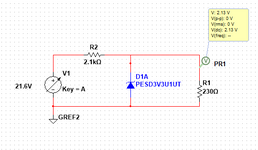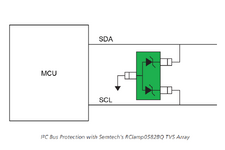LeanSol345
Junior Member level 1
Hello, I want to protect I2C Pins of Raspberry Pico from ESD and for the purpose, as I learnt, TVS Diode will be used. So I'm using PESD5V0L1UA such as shown in schematic picture for a sensor with I2C and 5V operating. But I think this is not correct because of different output voltage.
Guide me to correct it and indicate something I'm missing to understand. As far I know, the diode should be short to ground when Reverse Breakdown Voltage meets to threshold (5V), thus stopping from overvoltage to I2C pins.
Guide me to correct it and indicate something I'm missing to understand. As far I know, the diode should be short to ground when Reverse Breakdown Voltage meets to threshold (5V), thus stopping from overvoltage to I2C pins.

